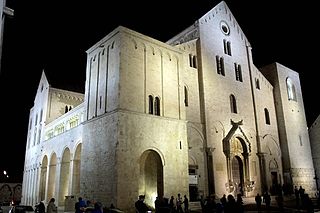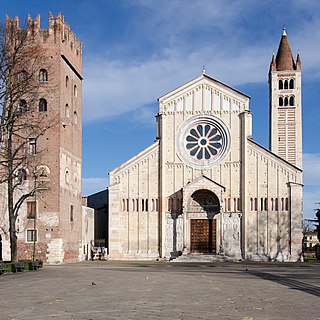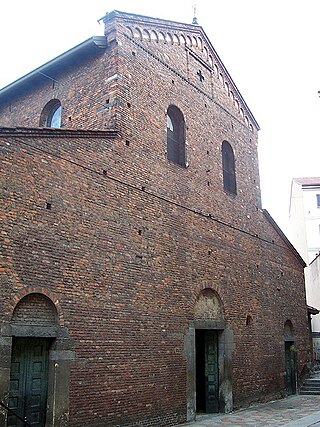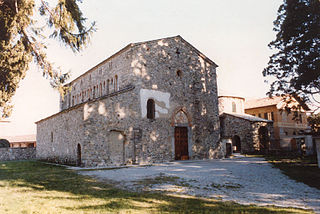
Arezzo is a city and comune in Italy and the capital of the province of the same name located in Tuscany. Arezzo is about 80 kilometres southeast of Florence at an elevation of 296 metres (971 ft) above sea level. As of 2022, the population was about 97,000.

The architecture of cathedrals and great churches is characterised by the buildings' large scale and follows one of several branching traditions of form, function and style that derive ultimately from the Early Christian architectural traditions established in Late Antiquity during the Christianization of the Roman Empire.

The Euphrasian Basilica or the Cathedral Basilica of the Assumption of Mary is a Roman Catholic basilica in the Istrian town of Poreč, Croatia. The episcopal complex, which comprises the basilica itself, a sacristy, a baptistery and the bell tower of the nearby archbishop's palace, is an excellent example of early Byzantine architecture in the Mediterranean region.
Abundius, venerated in the Catholic Church as Saint Abundius, was a bishop of Como, Northern Italy.

The Pontifical Basilica of Saint Nicholas is a church in Bari, Southern Italy that holds wide religious significance throughout Europe and the Christian world. The basilica is an important pilgrimage destination both for Roman Catholics and Orthodox Christians.

The Basilica of Sant'Ambrogio is a church in the center of Milan, northern Italy.

The Cathedral of St. Anastasia is the Roman Catholic cathedral of Zadar, Croatia, seat of the Archdiocese of Zadar, and the largest church in all of Dalmatia.

Prato Cathedral, or Cathedral of Saint Stephen, is a Roman Catholic cathedral in Prato, Tuscany, Central Italy, from 1954 the seat of the Bishop of Prato, having been previously, from 1653, a cathedral in the Diocese of Pistoia and Prato. It is dedicated to Saint Stephen, the first Christian martyr.

The Basilica di San Zeno is a minor basilica of Verona, northern Italy constructed between 967 and 1398 AD. Its fame rests partly on its Romanesque architecture and partly upon the tradition that its crypt was the place of the marriage of Shakespeare's Romeo and Juliet. It stands adjacent to a Benedictine abbey, both dedicated to St Zeno of Verona.

The Basilica of San Michele Maggiore is a church of Pavia, one of the most striking example of Lombard-Romanesque style. It dates from the 11th and 12th centuries.

The basilica of San Vincenzo in Prato is a church in Milan, northern Italy. It is the only one in city which has entirely maintained its original Palaeo-Christian appearance. The church is located in Via Daniele Crespi 6, Milan.
Saint Amantius of Como is venerated as the third bishop of Como. He was preceded by Felix of Como and Saint Provinus. He was succeeded by Saint Abundius. His feast day is 8 April.

The Basilica of San Simplicio is a Basilica in Olbia, northern Sardinia, Italy.

The Basilica of San Saturnino is a Palaeo-Christian church in Cagliari, southern Sardinia, Italy.

The Basilica di Sant'Andrea is the church of a monastery in Vercelli, Piedmont, northern Italy, founded in 1219 by Cardinal Guala Bicchieri and completed in 1227. It represents an early example of Gothic architecture in Italy, inspired by Cistercian models and featuring Romanesque elements as well.

Ancona Cathedral is a Roman Catholic cathedral in Ancona, central Italy, dedicated to Saint Cyriacus. It is the seat of the Archbishop of Ancona. The building is an example of mixed Romanesque-Byzantine and Gothic elements, and stands on the site of the former acropolis of the Greek city, the Guasco hill which overlooks Ancona and its gulf.

The Basilica di San Vincenzo is a church in Galliano, a frazione of Cantù, in Lombardy, northern Italy. An example of local Romanesque architecture, it was founded in 1007. The complex includes also a baptistry, dedicated to St. John the Baptist.

The Basilica of San Fedele in Como is located in the city center and is dedicated to Saint Fidelis martyr. It derives from an earlier Christian church, dating from the seventh century, dedicated to Euphemia.

The Church of Santa Maria Maggiore, also known as Sanctuary of the Spoliation, is a church in Assisi, Umbria, central Italy.

Palestrina Cathedral is a Roman Catholic cathedral located in Palestrina, region of Lazio, Italy. It is the episcopal seat of the Suburbicarian Diocese of Palestrina, and dedicated to Saint Agapitus.



















